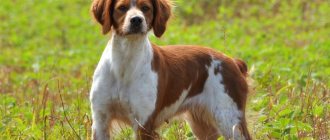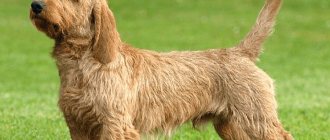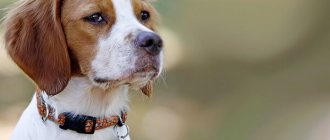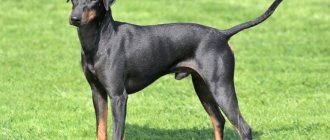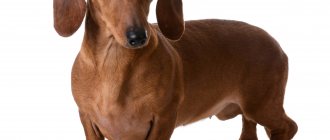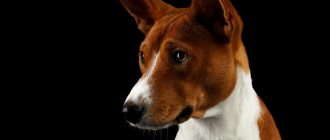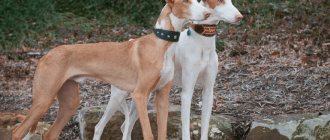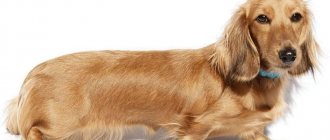The Breton epagnol or Épagneul breton (French: Épagneul breton, English: Brittany) is a gundog. The breed got its name from the region where it comes from. In many countries, these dogs are known as the Breton spaniel, but they hunt in a manner more typical of setters or pointers. The reason for its great popularity among hunters is that it is a very intelligent breed, calm and obedient.
Breed traits
Breed traits (on a 5-point scale)
| Breton epañol | |||
| Activity | in the house | 3.2 | |
| on the street | 4.6 | ||
| Obedience | training | 3.9 | |
| strangers | 3.9 | ||
| Domination | in family | 1.6 | |
| over dogs | 2.2 | ||
| Defending your territory | from people | 1.7 | |
| from dogs | 2.2 | ||
| Sociability | in family | 4.8 | |
| with strangers | 4 | ||
| with dogs | 3.4 | ||
| Concentration | in family | 1.1 | |
| in front of strangers | 1.6 | ||
| with dogs | 1.9 | ||
| Aggressiveness | in family | 1 | |
| to strangers | 1.3 | ||
| to the dogs | 1.9 | ||
| to cats | 2 | ||
| Family behavior | calmness | 4.3 | |
| demand for affection | 4.7 | ||
| excitability | 3.7 | ||
| playfulness | 4.4 | ||
| excessive barking | 2.4 | ||
| behavioral breakdowns | 2.1 | ||
| Tolerance for children | up to 4 years | 4.2 | |
| over 4 years old | 4.5 | ||
| Institutional use | watchman | 3.7 | |
| bodyguard | 2.1 | ||
This breed is often compared to the following dog breeds: German Shorthaired Pointer, English Springer Spaniel, Welsh Springer Spaniel, German Wirehaired Pointer, Beagle.
Photo of Breton epagnol:
Training
Starting from the age of three months, you can gradually begin to train your Breton. During this period, the puppy especially listens to its owner. Commands should be spoken in a soft voice. If the pet has correctly fulfilled the requirement, it needs to be praised and encouraged in some way. Otherwise, you can raise your voice a little.
In order for the puppy to quickly get used to his nickname (it is better if it is short), it should be repeated as often as possible.
You need to call the dog to you more often, pronouncing his name in a gentle voice. As soon as he runs up, you can treat him with something tasty or cuddle him. The baby will remember this pleasant moment and next time he will joyfully come running at the first call. A Breton must understand the word “no”. If he did something wrong, you can pat him on the sacrum. Accustoming to cleanliness. Every time after sleeping, eating and active games, the Breton should be taken outside to do his business. Otherwise, there will be piles and puddles in the house every 2 hours. When the puppy does his business in the right place, he must be praised, as if he had performed some kind of miracle. This way the Breton will quickly understand that his actions are correct and will try in every possible way to please his owner.
Breton epañol
General characteristics of the Breton Epagnole breed
The Breton Spaniel is the smallest pointing dog, one of the varieties of spaniels. Bred in France, almost unknown in Russia. Only a specialist can distinguish it from other spaniels or setters. The breed is working, intended for hunting. But thanks to its peaceful nature and people-oriented nature, this dog can become a good companion. If he is sufficiently busy with running and playing outside, at home he behaves calmly, obediently and affectionately with all family members.
| Options | Characteristic |
| breed name | Breton epagnol (French épagneul breton), French epagnol, Breton epagnol |
| a country | France |
| group of breeds according to the ICF classification | pointers, spaniel type |
| application | hunter, companion |
| character traits | sociable, hardworking, hardy, devoted, obedient |
| life expectancy | 12-14 years old |
| height | 46-52 cm |
| weight | 14-18 kg |
| aggressiveness | No |
| activity | high |
| intelligence | smart |
| difficulty of care | uncomplicated, sheds lightly, unpretentious |
pros
Compared to other hunting dogs, the Breton Spaniol has many advantages:
- balanced character;
- sociability, people-oriented;
- devotion;
- friendliness, lack of aggression;
- good attitude towards children;
- high intelligence, quick learner;
- unpretentiousness, suitable for keeping in an apartment;
- excellent working qualities;
- lack of stubbornness or desire to dominate.
Minuses
Before you get a Breton Epagnole, you need to know about the disadvantages of the breed, which can create problems for some owners. These dogs are suitable for hunters or owners leading an active lifestyle. They require long walks and physical activity. It is advisable to take your dog out into nature at least once a week so that it can frolic. It is not recommended to leave a dog alone for a long time; it requires constant communication with a person.
Bretons need early socialization and special education. It is important to consider that they have innate hunting instincts, so on the street they can chase a bird or a cat. It will not be possible to use an Epagnole as a guard dog, nor will it become a decorative dog. He requires constant attention, regular exercise and exercise.
Breton epagnoles on the hunt
The breed belongs to the long-haired continental pointers. This is a universal hunter: bloodhound, gun dog. Thanks to her keen senses, she can track any game. With this dog you can hunt birds, rabbits, foxes, and rodents. She can develop great speed, is resilient and passionate.
Epagnol is obedient and works well in a team. He combs the area in a special way, like a shuttle. When it smells prey, it takes a stance, then lies down. Can lift a bird onto its wing, exposing it to a shot. Then he finds killed game and brings it to the owner. You can hunt with a Breton anywhere: in a field, in a swamp, in a forest, near a pond. It is unpretentious and works in any weather conditions.
The video complements the characteristics of the breed:
Video: Breton epagnole. Planet of Dogs @my planet
Video: Breton epagnole on ilikepet. Breed characteristics, care
Video: Breton Epagnole - all about the dog breed | Breton Epagnole dog
Vices
All deviations from the given requirements are shortcomings (defects). Their severity is assessed in proportion to the severity of the deviations, as well as their impact on the welfare and health of the animal. The following are considered disqualifying defects:
- character defect (the dog is aggressive towards other animals and humans, biting);
- cowardice;
- dimensions different from the standard limits;
- converging lines of the muzzle and skull;
- excessive variegation;
- white spots on the ears or around the eyes. light, multi-colored eyes;
- strabismus;
- ectropy and entropy;
- undershot or overshot;
- depigmentation on the eyelids or nose.
History of the origin of the breed
The breed was bred in France, in the province of Brittany. That's why it got that name. The ancestors of the Spaniard were farm dogs that were used for hunting. Some researchers believe that they are descended from Pointers, English Setters, or Springer Spaniels. This opinion has not been proven, but the breed is now classified as spaniels.
The first mentions of such small hunting dogs date back to the 15th century; there are paintings from the 17th century with such hunters. They were officially described only in the middle of the 19th century by the English priest Davis. Breeders became interested in the breed and named it the Breton Epagnole. At the beginning of the 20th century, a club was organized and the first standard was created.
In the 30s of the 20th century, the breed became known and popular in the USA and Canada. In the middle of the century it was officially recognized by the International Canine Association. In Russia, Breton became known only in the 21st century, while the breed is still rare among us.
Nutritional Features
Despite their active lifestyle, Breton Spaniards often suffer from obesity, so you should carefully select foods to feed them.
Recommended diet:
- boiled or frozen meat: veal, beef, lean poultry;
- boiled offal;
- hard-boiled chicken eggs;
- sea fish, pitted;
- dairy products with a minimum of fat;
- boiled and raw vegetables;
- greenery;
- oatmeal, barley porridge and buckwheat.
Note! You should avoid feeding your pet pork, milk and pearl barley. You should also not give bones or add spices to food.
Appearance
The Breton Epagnole is a stocky, muscular dog of medium size with a graceful, harmonious build. The height of males is up to 52 cm, females are slightly smaller. Weight is 14-18 kg, the dog does not look heavy or massive. A distinctive feature of their appearance is their shortened tail; many puppies are born tailless.
Head
The head is wide, proportional to the body. The skull is rounded, the transition to the muzzle is smooth. The muzzle is elongated, cheekbones are flat, and the bite is scissor-shaped. The lips are thin and well pigmented. The upper one overlaps the lower one, but does not sag. The nose is black or brown, the nostrils are wide.
The ears are set high, mobile, hanging down. They are triangular in shape with rounded ends and medium in size. The eyes are oval, set wide, slightly slanted. The color of the iris is light or dark brown.
Frame
Square format case. The neck is of medium length, graceful and muscular. The back is short, straight, the loin is wide. The chest is voluminous, its depth occupies half the height of the dog at the withers, the stomach is tucked. The tail is set high, up to 10 cm long; when docked, 3-5 cm is left. Sometimes it is absent from birth. The dog holds its tail horizontally or lowered, and does not lift it up.
Limbs
Limbs are straight and muscular. Placed vertically, parallel to each other. The paws are compact, the toes are tightly pressed, the pads are hard. The movements are light and sweeping. The dog runs at a gallop and can run a long distance without getting tired.
Coat and color
The coat is medium length, thin, smooth, lying close to the body. On the back of the body it is longer, and may be slightly wavy. There is no undercoat.
The color is white with red, brown or black spots. There may be speckling on the limbs, face and chest. Mandatory white stripe running across the forehead to the tip of the nose.
Disqualifying faults
This breed is relatively young, the standard has been refined many times. The final version was adopted in 2003. According to it, dogs with the following defects are not allowed to participate in exhibitions and breeding:
- straight bite;
- round or bulging eyes;
- short neck;
- dewlap or fringes;
- weak pigmentation of the lips, eyelids and nose;
- plain color;
- white spots around the eyes or on the ears;
- a long tail;
- hair, short all over the body.
Photos complement the description of the appearance of these dogs:
Head
The dog's head has the correct shape, the skull is slightly rounded in front and on the sides. The transition from forehead to muzzle is quite smooth. The muzzle is straight. The nose is harmonious in color with the color of the animal, wide. The eyes are large, round and slightly elongated, very expressive. The color is usually consistent with the coat, but dark is preferred, although other colors are not considered a fault. The ears are triangular in shape, mobile, set high, of medium length. They are partially covered with soft wavy hair.
The character of these dogs
Breton Epagnole is popular as a companion. This is a good-natured, cheerful and sociable dog. She is calm, flexible, and has a balanced character. Gets along with all family members and is friendly. He loves children, treats them carefully, without showing displeasure at any pranks. The dog is ready to run and play with them all day, to protect them.
Breton Spaniolas are not prone to dominance, therefore they are obedient and flexible. They get along well with any pets. Although on the street they may show hunting instincts towards other people's cats, birds and rodents. They do not express aggression towards strangers, are friendly, and allow themselves to be petted.
This dog adapts to any lifestyle of its owner. He becomes very attached to him and misses him greatly when he is apart. With prolonged loneliness, a dog can develop depression. With a lack of physical activity, she can howl and ruin things. Loves to accompany the owner everywhere and participate in all activities. This dog is energetic, playful, and resilient. This is a wonderful companion for traveling, cycling, hiking. But most of all it is adapted for hunting - these qualities are innate in it.
The Bretons have the following character traits:
- equilibrium;
- cheerfulness;
- good nature;
- sociability;
- intelligence;
- curiosity;
- devotion.
Education and training
These dogs are smart and easy to train. The owners note that they understand a person perfectly and try to please. Their hunting qualities are innate; training can begin at 5-7 months. The dog is trained to track prey, moving in a “shuttle” motion, to freeze in a stance, to find and bring game. So that the dog is not afraid of gunshots, it must be socialized from an early age: familiarize it with noise, loud sounds, and unfamiliar people.
If the dog will not be used for hunting, it is enough for him to learn the usual commands: “come to me”, “near”, “place”, “sit”, “stand”, “no”, “fetch”. Even an inexperienced dog breeder can do the training, the main thing is to follow a few recommendations:
- start training from the first days the puppy appears in the house, all family members must adhere to the same requirements;
- be persistent, but not rude, avoid raising your voice and physical punishment;
- be patient, consistent, classes should be regular;
- For success, be sure to praise and reward the puppy with treats.
Theses
- This is a very, very energetic dog. She needs at least an hour of intense exercise a day, without which she can become destructive.
- In addition to the body, you also need to exercise the mind, since the Bretons are very smart. Ideal for training and sports.
- These dogs try to please their owner and there is no need to treat them roughly.
- They love people and do not like to remain for a long time without communication with their owner. If you are away from home for a long time, then get her a companion.
- They are friendly and love children.
- Do you want to buy a Breton Epagnole? A puppy will cost from 35,000 rubles, but these dogs are quite rare in Russia and cannot be found everywhere.
Maintenance and care
This is a very active dog and needs regular exercise. Therefore, the best way to maintain it is a country house with a large plot. The Breton Spaniard cannot be chained or locked in an enclosure. He also needs constant contact with a person. With any method of keeping, it is necessary to walk the dog 2-3 times a day for at least an hour.
Caring for epagnoles is simple; normal hygiene procedures are required.
- The coat is thick, of medium length, but without undercoat. You need to brush it 1-2 times a week with a stiff bristle brush. During molting - every day. A haircut may be required before the show.
- Wool does not get dirty and has no smell. Therefore, you can bathe your dog once every 2-3 months or when dirty. After every walk you need to wash your paws and belly.
- Clean your ears from wax and dirt once a week. For this purpose, use special wet wipes or a cotton pad soaked in veterinary lotion. After walking in nature or hunting, the ears should be examined for ticks and injuries.
- Wipe your eyes daily with tea or chamomile decoction.
- Brush your teeth once a week. But you can regularly give your dog chewable treats to remove plaque.
- If the claws do not grind down on the asphalt, they need to be trimmed every month.
- Treat the fur monthly to remove external parasites. Give anthelmintic drugs every 2-3 months.
Nutrition
These active dogs' diets should be high in protein but low in carbohydrates. They are prone to weight gain, so you need to choose your food carefully. The easiest way to control the amount and calorie content is when feeding industrial feed. They must be at least super-premium class. The following brands are well suited for Breton epagnoles:
- Orijen;
- Acana;
- Grandorf;
- Nature Holistic;
- Farmina ND.
With natural feeding, the diet should consist of more than 50% lean meat and offal. It is mixed with cereals and vegetables, and additionally given fermented milk products. It is useful to give sea fish and egg yolk a couple of times a week. With this feeding, vitamin supplements are necessary.
Dogs should not be fed fatty, fried, spicy or salty foods. Legumes, pork, bones, sweets, and confectionery are prohibited.
Health
The average life expectancy of a Breton Epagnole is 13-14 years. They are in good health, although routine vaccinations are mandatory. Sometimes representatives of the breed develop the following diseases:
- joint dysplasia;
- epilepsy;
- retinal atrophy;
- discoid lupus erythematosus;
- hypothyroidism;
- otitis.
Application
Today, the French Epagnole is bred as a companion dog. He gets along with any family and adapts to people's lifestyles.
However, the purpose of the Breton epagnol is hunting game birds. It is used to track partridges, pheasants, woodcocks, and quails, although the pet handles all birds equally well. The dog is tireless and can work all day. It is equally good in the field, forest and on ponds.
In the heat, the dog is allowed to rest and cool down every hour - otherwise he will develop heatstroke or sunstroke.
The Breton Spaniel has an excellent sense of smell. He can smell a bird 70 -100 meters away.
If the French Cocker Spaniel takes birds on its wing, then the Breton Spaniel is a hunter of a different order. He combs the field with a shuttle at a distance of 50-100 m in each direction. And when it senses prey, it freezes in a stance and patiently waits for its owner. Only when he approaches does the dog carefully approach the bird. Moreover, a quail or a pheasant is often scared away by a person so as not to expose the pet to a gun.
Some Breton epagnols master the highest art of cops - an announcement or a report. When the dog smells game, it carefully leaves the stand, looks for the owner and leads him to the bird left for a while.
How to buy a Breton Epagnole puppy
You must buy a purebred puppy from a nursery. The breed is quite rare in our country, but you can find a conscientious breeder. Information about them can be obtained from the National Breed Club, at amateur forums, and at exhibitions. It’s easier to buy a companion; such a puppy will cost 20-30 thousand rubles. There are long queues for working dogs; such puppies cost 40-60 thousand rubles.
Before purchasing, you need to study the reputation of the breeder and meet the parents. They must have an appearance that meets the standard, pedigrees, and certificates from exhibitions. Puppies must have puppy cards and veterinary certificates. They sell babies at 2-3 months. When choosing, you need to pay attention to behavior: the puppy should be active, playful, and not cowardly. The following signs indicate health: a wet, cool nose, smooth hair without bald spots, and no discharge from the eyes and ears.
The photo shows what the puppies look like:
The video complements the description of the breed:
Video: Breton epagnole. Pros and cons, price, how to choose, facts, care, history
Video: Hunting with epañol Breton
Video: Breton epagnol (Breton epagnol)
Those who want to have a loyal active companion or an ideal hunting dog should pay attention to the Breton Epagnole. This is an obedient, cheerful and intelligent dog that will bring many joyful moments and will become a loyal friend and favorite of all family members.
Mating
It is best to introduce dogs on the territory of the male.
Mating of purebred individuals is best carried out on the territory of the male, so that he feels like a master. It takes about a week to introduce the dogs so that they get used to each other.
Owners of purebred dogs agree to breed for a certain amount, which is usually about 20 thousand rubles.
Feeding
The Breton Epagnole can eat any kind of food. At the same time, experienced dog breeders recommend choosing industrial products for your daily diet. This is explained by its balance and ease of use.
When choosing dry food, it is best to give preference to premium options designed for medium-sized dogs leading an active lifestyle.
If preference is given to natural nutrition, then the diet must include lean meat, cereals, sea fish, bones, offal, vegetables, fruits, and dairy products.
Epagnol Breton: interesting facts
The Breton Epagnole is one of those breeds about which a lot of interesting things can be told:
- According to one version, the name of the breed comes from the verb s'espaignir, which means “to lie down, stretch out” and characterizes the dog’s working style. According to another theory, the word "epanyol" has Spanish roots and indicates a relationship with Spanish bird dogs.
- According to some reports, to improve the exterior and working qualities of Bretons, the blood of an English setter, pointer and springer spaniel was infused into them. But this information is still the subject of heated debate.
- The Breton Epagnole has a developed sense of smell and is able to smell a flock of birds at a distance of 70 m.
average price
Despite the fact that the breed is rare, the cost of puppies is relatively low. In most cases, it varies within 20,000 rubles. Without documents, you can buy a dog even cheaper - for 7,000-12,000. The most expensive are show puppies from purebred parents; their cost can exceed 50,000 rubles.
